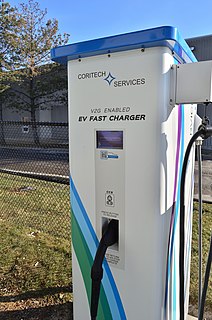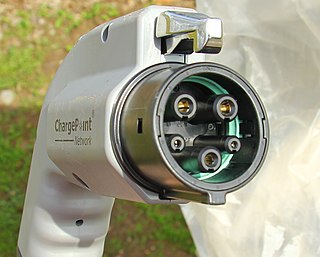
An electric vehicle (EV) is a vehicle that uses one or more electric motors for propulsion. It can be powered by a collector system, with electricity from extravehicular sources, or it can be powered autonomously by a battery. EVs include, but are not limited to, road and rail vehicles, surface and underwater vessels, electric aircraft and electric spacecraft.

The Toyota RAV4 EV is an all-electric version of the popular RAV4 SUV produced by Toyota until 2014. Two generations of the EV model were sold in California, and to fleets elsewhere in the US, with a gap of almost ten years between them.

Vehicle-to-grid (V2G) describes a system in which plug-in electric vehicles (PEV), such as battery electric vehicles (BEV), plug-in hybrids (PHEV) or hydrogen fuel cell electric vehicles (FCEV), communicate with the power grid to sell demand response services by either returning electricity to the grid or by throttling their charging rate. V2G storage capabilities can enable EVs to store and discharge electricity generated from renewable energy sources such as solar and wind, with output that fluctuates depending on weather and time of day.
Avcon is a company that manufactures charging interfaces for battery electric vehicles (EV). The lettering convention is Avcon for the company and AVCON (capitals) for the EV charging connector.

Inductive charging is a type of wireless power transfer. It uses electromagnetic induction to provide electricity to portable devices. Inductive charging is also used in vehicles, power tools, electric toothbrushes, and medical devices. The portable equipment can be placed near a charging station or inductive pad without needing to be precisely aligned or make electrical contact with a dock or plug.

A charging station, also called an EV charger, electric vehicle supply equipment (EVSE) or simply charger is a piece of equipment that supplies electrical power for charging plug-in electric vehicles.
WiTricity is an American wireless charging technology company based in Watertown, Massachusetts. The Massachusetts Institute of Technology (MIT) spin-off was founded by professor Marin Soljačić in 2007. WiTricity technology allows wireless power transfer over distance via magnetic resonance and the company licenses technology and reference designs for wireless electrical vehicle (EV) charging as well as consumer products such as laptops, mobile phones and televisions.

An electric car, battery electric car, or all-electric car is an automobile that is propelled by one or more electric motors, using only energy stored in batteries. Compared to internal combustion engine (ICE) vehicles, electric cars are quieter, have no exhaust emissions, and lower emissions overall. In the United States and the European Union, as of 2020, the total cost of ownership of recent electric vehicles is cheaper than that of equivalent ICE cars, due to lower fueling and maintenance costs. Charging an electric car can be done at a variety of charging stations; these charging stations can be installed in both houses and public areas.

SAE J1772, also known as a J plug, is a North American standard for electrical connectors for electric vehicles maintained by the SAE International and has the formal title "SAE Surface Vehicle Recommended Practice J1772, SAE Electric Vehicle Conductive Charge Coupler". It covers the general physical, electrical, communication protocol, and performance requirements for the electric vehicle conductive charge system and coupler. The intent is to define a common electric vehicle conductive charging system architecture including operational requirements and the functional and dimensional requirements for the vehicle inlet and mating connector.

Resonant inductive coupling or magnetic phase synchronous coupling is a phenomenon with inductive coupling where the coupling becomes stronger when the "secondary" (load-bearing) side of the loosely coupled coil resonates. A resonant transformer of this type is often used in analog circuitry as a bandpass filter. Resonant inductive coupling is also used in wireless power systems for portable computers, phones, and vehicles.

The adoption of plug-in electric vehicles in the United States is supported by the American federal government, and several states and local governments. As of December 2021, cumulative sales in the U.S. totaled 2.32 million highway legal plug-in electric cars since 2010, led by all-electric cars. The American stock represented 20% of the global plug-in car fleet in use by the end of 2019, and the U.S. had the world's third largest stock of plug-in passenger cars after China (47%) and Europe (25%).

CHAdeMO is the trade name of a fast charging method for battery electric vehicles delivering up to 62.5 kW by 500 V, 125 A direct current via a special electrical connector. A revised CHAdeMO 2.0 specification allows for up to 400 kW by 1000 V, 400 A direct current.

On-Line Electric Vehicle or OLEV is an electric vehicle system developed by KAIST, the Korea Advanced Institute of Science and Technology, which charges electric vehicles wirelessly while moving using inductive charging. Segments composed of coils buried in the road transfer energy to a receiver or pickup that is mounted on the underside of the electric vehicle, which powers the vehicle and charges its battery.
The UCLA Smart Grid Energy Research Center (SMERC), located on the University of California Los Angeles (UCLA) campus, is an organization focused on developing the next generation of technologies and innovation for the SmartGrid. Partnerships with government, technology providers, DOE research labs and universities, utilities, policy makers, and electric vehicle and appliance manufacturers provide SMERC with diverse capabilities and exceptional, matured leadership.

The Combined Charging System (CCS) is a standard for charging electric vehicles, which uses the Combo 1 and Combo 2 connectors to provide power at up to 350 kilowatts. These two connectors are extensions of the IEC 62196 Type 1 and Type 2 connectors, with two additional direct current (DC) contacts to allow high-power DC fast charging.

The electric vehicle industry in India is a growing industry. The central and state governments have launched schemes and incentives to promote electric mobility in the country and some regulations and standards are also in place. While the country stands to benefit in a large way by switching its transport from IC engines to electric motor-powered, there are challenges like lack of charging infrastructure, high initial cost and lack of electricity produced from renewable energy. Still, e-commerce companies, car manufacturers, app-based transportation network companies and mobility solution providers have entered the sector and are slowly building up electric car capacity and visibility.
ISO 15118Road vehicles -- Vehicle to grid communication interface is an international standard defining a vehicle to grid (V2G) communication interface for bi-directional charging/discharging of electric vehicles. The standard provides a Plug & Charge feature used by some electric vehicle networks.

SAE J3068 is a North American recommended practice published and maintained by SAE International. J3068 defines electrical connectors and a control protocol for electric vehicles. It has the formal title "SAE Surface Vehicle Recommended Practice J3068". J3068 defines a system of conductive power transfer to an electric vehicle using a coupler capable of transferring single-phase and three-phase AC power as well as DC power, and defines a digital communication system for control. J3068 also specifies requirements for the vehicle inlet, supply equipment connector, mating housings and contacts.

Smart charging refers to a charging system where electric vehicles, charging stations and charging operators share data connections. Through smart charging, the charging stations may monitor, manage, and restrict the use of charging devices to optimize energy consumption. Comparing with uncontrolled charging, smart charging will flatten the electricity usage peak by shifting the peak due to vehicle charging away from the peak due to other consumption.
SAE J2954 is a standard for wireless power transfer (WPT) for electric vehicles led by SAE International. It defines three classes of charging speed, WPT 1, 2 and 3, at a maximum of 3.7 kW, 7.7 kW and 11 kW, respectively. This makes it comparable to medium-speed wired charging standards like the common SAE J1772 system. A much more powerful WPT9 is being defined in J2954/2 for 500 kW charging for heavy-duty vehicles which have the room necessary to mount the larger induction plate.














